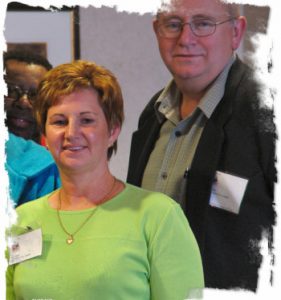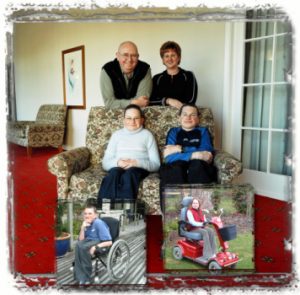The Longest Journey Begins With the First Step (by Jenny Noble, Mucolipidosis III Parent)
Conference Home
Children’s Program
Glycoproteinosis Workshop
Personal Reflections
 Mucolipidosis has taken a leap into the future and found a home! I want to thank Paul Murphy and his team of conference organizers for including ML II and ML III as part of ISMRD’s focus on the Glycoprotein group of diseases. The conference in Rockville was a truly amazing experience, the simplicity of the information given at the Family conference was just wonderful. Never in 17 years of diagnosis have we heard an explanation of how the enzymes get into the Lysosome explained so simply or in our case how the messages are missing on some of the enzymes. It is incredibly exciting seeing ML families finally uniting, sharing information and just supporting one another. During the conference we became known as the Stalkers, a group of parents crying out for information and answers. We used the weekend well to sow many seeds. Those poor Doctors must have wondered what they were up against, but it was a wonderful opportunity to spread the exciting results of Pamidronate treatment in ML2 and 3.
Mucolipidosis has taken a leap into the future and found a home! I want to thank Paul Murphy and his team of conference organizers for including ML II and ML III as part of ISMRD’s focus on the Glycoprotein group of diseases. The conference in Rockville was a truly amazing experience, the simplicity of the information given at the Family conference was just wonderful. Never in 17 years of diagnosis have we heard an explanation of how the enzymes get into the Lysosome explained so simply or in our case how the messages are missing on some of the enzymes. It is incredibly exciting seeing ML families finally uniting, sharing information and just supporting one another. During the conference we became known as the Stalkers, a group of parents crying out for information and answers. We used the weekend well to sow many seeds. Those poor Doctors must have wondered what they were up against, but it was a wonderful opportunity to spread the exciting results of Pamidronate treatment in ML2 and 3.
Our Journey with Pamidronate is a long one based on our efforts to firstly discover why Hayden and Sarah had so much pain and why conventional drugs didn’t work, but our involvement began when we started asking questions of all our International Experts, such as:
- Why do these children have such high levels of pain?
- Why don’t anti-inflammatory drugs work?
- If they don’t have arthritis what are we dealing with?
- We must be missing something there has to be an answer?
While attending an MPS meeting in Australia my husband, Paul, and I convened a medical meeting which consisted of one UK Dr, two Australian Drs, and New Zealand’s metabolic nurse. We were determined to come away from this meeting with a plan of action if not a possible treatment. The UK Dr had given a presentation about a list of drugs that help with some of the problems that MPS patients have. He mentioned a group of drugs called Bisphosphonates, which are useful for pain control. Finally a mention of a group of drugs that we had never heard of.
This possible treatment was discussed at our meeting, but it was thought that Bisphosphonates would only work for chronic pain and bone diseases and unless Sarah had either of these conditions it would not be worth considering, but being parents who don’t take no for an answer we pushed ahead and asked our many questions. This lead to Sarah being seen at Westmead Children’s Hospital in Sydney for a completed medical work up. For us that meant going home to New Zealand and making arrangements for us to travel back to Australia, which we did and so began a week of intensive testing for Sarah to come up with a diagnosis of osteopenia now known as Secondary Metabolic Bone disease.
The recommended treatment for bone disease was PAMIDRONATE! Finally this looked like something that would make Hayden and Sarah’s live more bearable. After 6 months of treatment we saw incredible changes in pain, sleeping and over mobility and well being. Our Pediatrician decided that we really needed to document what we were seeing and suggested that we start forming the basis of a Medical paper that would have several Authors. I suddenly found myself pulling data for the Drs. proof reading and supplying correct dates and stages that Hayden and Sarah went through prior to treatment and of course all the changes that happened during the 15 month study.
Since the ML3 study Prof David Sillence has carried out a study on ML2 in Australia and this has now been submitted for publication. Here in New Zealand we have a patient who has Maroteaux-Lamy using Pamidronate, with results of well being, no pain, sleeping, wanting to get out and about. The questions being asked now are Is this a possible treatment for other Lysosomal Patients? It certainly needs to be considered and researched. How can ISRMD help? We need and International bone study which requires funding and co-ordination. We need to look at other Lysosomal diseases and discuss the options of Pamidronate. We need to get these case studies out into the world of Lysosomal Diseases. We would like to leave you all with this thought: “the longest journey starts with the first step”
 Postscript: Jenny gave voice to the quest she describes by becoming a member of ISMRD’s Board of Directors following the conclusion of the conference. She is also Secretary for Lysosomal Diseases New Zealand.
Postscript: Jenny gave voice to the quest she describes by becoming a member of ISMRD’s Board of Directors following the conclusion of the conference. She is also Secretary for Lysosomal Diseases New Zealand.
